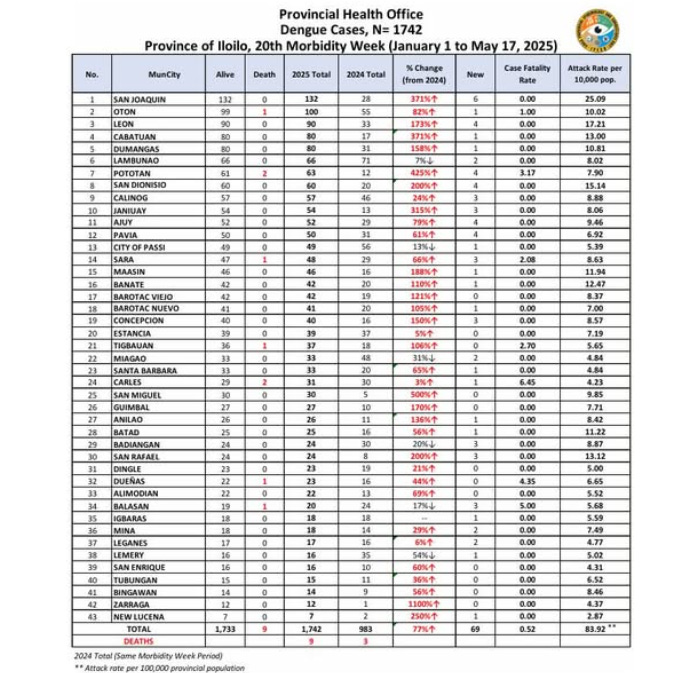As of the 20th Morbidity Week Report from the Epidemiology and Surveillance Unit of the Provincial Health Office, dengue cases in Iloilo have reached 1,742, with nine reported deaths. Current dengue cases are 77% higher compared to the same reporting period in 2024.
Epidemiological data indicate that cases are expected to continue rising, with a potential peak in July or August.
Children aged one to nine comprised 34.15 percent of the total cases, followed by those in the 10 to 19 age group with 28.42 percent.
Ayoko sa Lamok: Filipino youth’s battle against dengue fever
The Iloilo Provincial Health Office (IPHO) is encouraging the public to be proactive and intensify the observance of the 4S strategy amid the high incidence of dengue: 𝙎𝙚𝙖𝙧𝙘𝙝 𝙖𝙣𝙙 𝘿𝙚𝙨𝙩𝙧𝙤𝙮 𝙈𝙤𝙨𝙦𝙪𝙞𝙩𝙤 𝘽𝙧𝙚𝙚𝙙𝙞𝙣𝙜 𝙎𝙞𝙩𝙚𝙨, 𝙎𝙚𝙘𝙪𝙧𝙚 𝙎𝙚𝙡𝙛 𝙋𝙧𝙤𝙩𝙚𝙘𝙩𝙞𝙤𝙣, 𝙎𝙚𝙚𝙠 𝙀𝙖𝙧𝙡𝙮 𝘾𝙤𝙣𝙨𝙪𝙡𝙩𝙖𝙩𝙞𝙤𝙣 and 𝙎𝙪𝙥𝙥𝙤𝙧𝙩 𝙁𝙤𝙜𝙜𝙞𝙣𝙜 𝙖𝙣𝙙 𝙎𝙥𝙧𝙖𝙮𝙞𝙣𝙜 𝙞𝙣 𝙝𝙤𝙩𝙨𝙥𝙤𝙩 𝙖𝙧𝙚𝙖𝙨.
Dr. Rodney Labis, head of the IPHO health service delivery division encouraged the public to join the regular cleanup conducted every Monday at 4 p.m. under the “Limpyo Iloilo, kada Lunes nga lIhok Kontra Lamok” campaign of the provincial government.
Dengue is a disease caused by a virus spread through mosquito bites. The disease can take up to 2 weeks to develop with illness generally lasting less than a week.
Symptoms from dengue include fever, headache, nausea, vomiting, rash, muscle and joint pain, and minor bleeding.
Dengue can become severe within a few hours. Severe dengue is a medical emergency, usually requiring hospitalization.
In severe cases, health effects can include hemorrhage (uncontrolled bleeding), shock (seriously low blood pressure), organ failure, and death.






